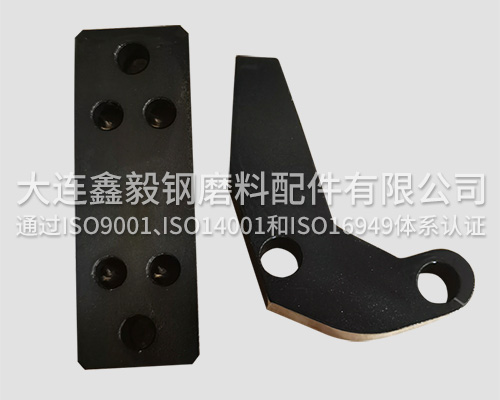Welcome to the official website of Dalian Xinyi steel abrasive parts Co., Ltd!
Dalian Xinyi steel abrasive parts Co., Ltd
Contact: Manager Zhang
Telephone: 0411-39630390
0411-39569620
mobile phone:13795133932
website:en.dlxyg.com.cn
Address: No. 10, Shengsheng Second Road, Dalian Economic and Technological Development Zone
Office worker: Quanshui P3, Ganjingzi District, Dalian
Dalian blackening surface treatment, as an economical and practical metal surface treatment process, has a wide range of applications in industrial production and daily life. Through a reasonable process flow and strict operating standards, blackening treatment can effectively improve the corrosion resistance and appearance quality of metals, providing guarantees for product performance and service life. However, with the increasing environmental requirements, blackening treatment technology is also facing new challenges and opportunities. In the future, with the continuous advancement of technology, the blackening process will develop towards a more environmentally friendly, efficient, and multifunctional direction.
The concentration of black liquor directly affects the rate and thickness of oxide film formation, and requires regular testing and adjustment. The temperature of blackening treatment affects the reaction rate and the quality of the oxide film, and needs to be controlled within an appropriate range. The time of blackening treatment affects the thickness and uniformity of the oxide film, and needs to be adjusted according to the size and shape of the part. The pH value of the black liquor affects the formation and stability of the oxide film, and requires regular testing and adjustment.
How to detect the thickness of the oxide film after blackening surface treatment in Dalian?
Magnetic measurement method
Principle: Use a magnetic thickness gauge to measure the thickness of the non-magnetic coating layer on a ferromagnetic substrate. The oxide film is a non-magnetic substance, and the substrate is a ferromagnetic material. The thickness of the oxide film is determined by measuring the change in magnetic flux between the probe and the substrate.
Operation: Place the probe of the magnetic thickness gauge vertically on the surface being measured, gently press to ensure good contact between the probe and the surface, and read the thickness value displayed by the instrument. Multiple measurements are required at different locations to obtain more accurate results.
Features: Easy and fast operation, no damage to the sample, and can be measured on site. However, the measurement accuracy is affected by factors such as the magnetic uniformity of the substrate and surface roughness.
Metallographic microscope method
Principle: By observing the sample prepared by metallography and using the magnification function of the microscope, the thickness of the oxide film can be directly measured.
Operation: First, perform metallographic preparation processes such as cutting, embedding, grinding, and polishing on the sample. Then, use a suitable corrosive agent to corrode the sample, so that the interface between the oxide film and the substrate is clearly displayed. Measure the thickness of the oxide film under a metallographic microscope using a micrometer in the eyepiece.
Features: High measurement accuracy, allowing for intuitive observation of the microstructure and morphology of oxide films. But the operation process is relatively complex, requiring professional equipment and technical personnel, and has a certain degree of damage to the sample.
X-ray diffraction method
Principle: When X-rays are irradiated onto the surface of an oxide film, diffraction occurs. By analyzing the intensity and position of specific diffraction peaks in the diffraction pattern, the thickness of the oxide film can be calculated.
Operation: Place the sample on the sample stage of the X-ray diffractometer, select the appropriate X-ray source and diffraction conditions, collect diffraction data, and then analyze and calculate it through the corresponding software.
Features: Accurate measurement results and simultaneous acquisition of phase structure information of oxide film. But the equipment is expensive, the operation is complex, the measurement speed is slow, and the requirements for sample preparation are high.
Electrolytic thickness measurement method
Principle: Based on Faraday's law, the thickness of the oxide film is calculated by measuring the amount of electricity consumed during the electrolysis process by electrolyzing the oxide film.
Operation: Use the sample as the anode, place it in a specific electrolyte, and form an electrolytic cell with a known area of cathode. Apply a certain voltage or current to cause electrolytic dissolution of the oxide film, record the electrolysis time and amount of electricity, and calculate the thickness of the oxide film according to relevant formulas.
Features: High measurement accuracy, suitable for measuring the thickness of oxide films on various metal substrates. But the operation process is relatively complicated, requiring professional electrolysis equipment and electrolyte, and has a certain degree of pollution to the environment.
The oxide film formed by blackening treatment can effectively isolate air and moisture, preventing metal rusting. Blackening treatment gives the metal a deep blue or black luster, enhancing the appearance and texture of the product. The equipment and materials for blackening treatment have low costs and are suitable for large-scale production. The process flow of blackening treatment is relatively simple, easy to operate, and easy to master.
The oxide film formed by blackening treatment has good corrosion resistance and can effectively prevent the rusting of metal parts. The oxide film has a certain hardness and can improve the wear resistance of metal parts. The metal surface after blackening treatment appears black or dark blue, with a good decorative effect. The equipment and process for blackening treatment are relatively simple and cost-effective.

![]()
Office address: P3 Quanshui District, Ganjingzi District, Dalian
Factory address: No. 10, Shengsheng Second Road, Dalian Economic and Technological Development Zone
Copyright © http://en.dlxyg.com.cn/ 大连鑫毅钢磨料配件有限公司 Specializing inDalian sandblasting,Dalian shot blasting,Dalian blackened surface treatment,Welcome to inquire!
辽ICP备18004327号 Powered by Clouds platform Technical Support:Joint enterprise Era
 | Wechat scan Pay attention to our timely information |